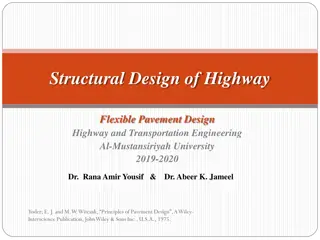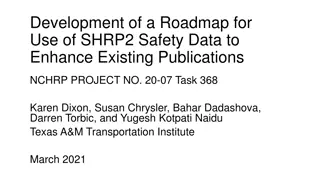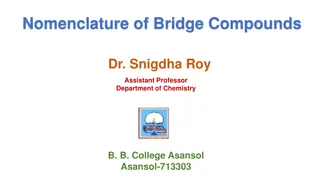Comparison of BRASS and AASHTO Standard Specifications in Bridge Engineering
Explore the key differences between the BRASS-GIRDER and AASHTO Standard Specification engines in bridge design calculations. Topics covered include load factor calculations, live load distribution factors, transverse live load application, critical vehicle positions, and member stiffness considerations for steel girders. Get insights into how these engines handle various aspects of structural analysis in bridge design.
Download Presentation

Please find below an Image/Link to download the presentation.
The content on the website is provided AS IS for your information and personal use only. It may not be sold, licensed, or shared on other websites without obtaining consent from the author. Download presentation by click this link. If you encounter any issues during the download, it is possible that the publisher has removed the file from their server.
E N D
Presentation Transcript
Differences Between BRASS and AASHTO Standard Spec Engines Virtis Opis BRIDGEWare Users Group Meeting 2011 Helena, Montana 1
Standard Spec refers to ASD and LFD found in the AASHTO Standard Specifications AASHTO Std Engine Version 6.3 and BRASS-GIRDER Version 6.0.3 are compared 2
General Features Impact Factor Calculation BRASS-GIRDER For moment, L = average span length of the spans on which the vehicle is located. For shear, L = loaded portion of the span. For a given node, two lengths are considered, L1 and L2. Initially, L1 = span length and L2 = zero. If the front or rear axle is on the span and left of the node point, L1 = distance from the left support to the node point. If the front or rear axle is on the span and right of the node point, L2 = distance from the node point to the right support. Then, L = max of L1 and L2. AASHTO Std Engine According to Article 3.8.2.2 for the loaded length L. Uses the span length of the point of interest. 3
General Features Live Load Distribution Factors AASHTO Std Engine Uses the corresponding distribution factors for shear and moment. If the shear factor is not entered, the moment factor will be used for shear effects. Computed if not entered. BRASS-GIRDER Uses the moment distribution factor for both moment and shear effects. 4
General Features Transverse Live Load Application to Floorbeams AASHTO Std Engine Applies the transverse live load at the stringer locations BRASS-GIRDER Applies transverse live load directly to the floor beam as though the stringers do not exist 5
General Features Algorithm to Locate the Critical Vehicle Positions AASHTO and BRASS may result in different critical vehicle positions. The relative difference in live load actions is usually within 5%. AASHTO Std Engine Loads influence lines by positioning the vehicle over the peaks. Applies each axle and the CG of the vehicle to the peak. BRASS-GIRDER Marches the vehicle across the influence line based on a wheel advancement denominator input by the user. 6
Steel Girders Member Stiffness Used in Structural Analysis AASHTO Std Engine Composite sections are determined based on the entered shear connector ranges. Where shear connectors are present, the beam plus slab properties are considered in the FE model. BRASS-GIRDER Uses positive flexure properties (beam + slab) in positive moment regions and negative flexure properties (beam + rebar) in negative moment regions. These regions are entered by the user in the BRASS LFD/ASD Engine Properties window. 7
Steel Girders Article 10.48.3 Transitions The maximum strength of sections with geometric properties falling between the limits of Articles 10.48.1 and 10.48.2 may be computed by straight-line interpolation, except that the web thickness must always satisfy Article 10.48.1.1(b). AASHTO Std Engine Implemented BRASS-GIRDER Not implemented 8
Steel Girders Article 10.57.2 Composite Sections At composite sections, the maximum overload flange stress shall not exceed 0.95Fy. AASHTO Std Engine Uses 0.95 factor BRASS-GIRDER Uses 0.80 factor for composite sections in negative moment regions. 9
Steel Girders Article 10.57 OVERLOAD Web bend-buckling shall be checked for the overload according to Equation (10-173) AASHTO Std Engine Implemented BRASS-GIRDER Not implemented 10
Steel Girders Allow Plastic Analysis Control Option AASHTO Std Engine Implemented. Plastic moment capacity is computed if the section meets the Spec requirements to be considered compact. BRASS-GIRDER Not implemented. Uses its Member Alternative engine properties to indicate the adjacent support POI are compact. If these POI are compact, plastic analysis is allowed if the section meets the spec requirements. If not, plastic analysis is not allowed. This engine setting is done on a span basis, so one span could be analyzed plastic while another one wouldn t be. 11
Steel Girders Built-up Section Web Depth AASHTO Std Engine Uses plate depth entered by user BRASS-GIRDER Computes web depth as back-back angle depth minus the flange thicknesses 12
Steel Girders Rate Bearing Stiffeners Control Option AASHTO Std Engine Not implemented BRASS-GIRDER Implemented 13
Steel Girders ASD Consider holes in tension flanges when computing allowable tension stress AASHTO Std Engine Considers holes in tension flanges when computing the allowable stress as per MBE Tables 6B.6.2.1.1 and 6B.6.2.1.2. BRASS-GIRDER Does not consider holes in the beam. 14
Prestressed Concrete Girders Prestressing Steel Tension Rating Factor AASHTO Std Engine Implemented BRASS-GIRDER Not implemented 15
Prestressed Concrete Girders Article 9.20.2.2 AASHTO Std Engine No limit on Mcr/Mmax BRASS-GIRDER Controlled by engine data: No limit on Mcr/Mmax Limit Mcr/Mmax to 1.0 16
Prestressed Concrete Girders Prestressing Force Along the Length of Beam AASHTO Std Engine Varies linearly from zero to a force corresponding to stress fse at the transfer length and to a force corresponding to stress f*su at the development length and beyond BRASS-GIRDER Constant 17
Prestressed Concrete Girders Article 9.20.1.4 AASHTO Std Engine Implemented. Sections located within h/2 from face of support are evaluated for shear acting at the h/2 location. BRASS-GIRDER Not implemented 18
Prestressed Concrete Girders MBE 6B.5.3.3 Prestressed Concrete Use flexural strength reduction factor k when Mn is less than 1.2Mcr AASHTO Std Engine Implemented. Controlled by a control option on the Member Alternative window. BRASS-GIRDER Not implemented 19
Prestressed Concrete Girders Support Positions AASHTO Std Engine Uses simple span bearing span lengths for DL1 analysis and centerline of support span lengths for DL2 and LL analyses. Analysis points considered for DL1 analysis correspond to tenth points of the continuous span lengths used for DL2 and LL analyses. Analysis points for which the results are reported correspond to tenth points of the continuous span lengths. BRASS-GIRDER Uses the same support positions, simple span bearing span lengths or centerline of support span lengths, for all stages. Non- composite stage is considered as simple spans and composite stage as continuous spans. 20
Prestressed Concrete Girders Analysis Points of Interest AASHTO Std Engine Tenth points and user- defined points of interest. Section change points selection will cause ratings to be computed at the h/2 distance from support, drape points, etc. BRASS-GIRDER Tenth points and user- defined points of interest only 21
Prestressed Concrete Girders Load Factor Concrete Stress Limits AASHTO Std Engine Uses the values entered on the Stress Limits Sets window. If the values are not entered, computes the allowables as per the Std Specifications. BRASS-GIRDER Does not use the values entered on the Stress Limits Sets window. Computes the allowables as per the Std Specifications. 22
Prestressed Concrete Girders Final Allowable Tensile Stress AASHTO Std Engine Uses the LFD Final allowable tension in the Stress Limit Sets window. If this value is not entered, uses the INVY ASD Factors P/S Concrete Tens. in the Member Alternative window. If INV ASD factor is not entered, the allowable is computed as per the Std Spec. BRASS-GIRDER Uses the INVY ASD Factors P/S Concrete Tens. in the Member Alternative window. If INV ASD factor is not entered, the allowable is computed as per the Std Spec. 23
Prestressed Concrete Girders Composite Slab Designation AASHTO Std Engine Considers regions of the deck to be composite if the effective slab thickness and width are entered on the Deck Profile window and one of the following are entered on the PS Shear Reinforcement Ranges window: Vertical reinforcement extends into deck "Composite" horizontal reinforcement range entered Horizontal shear reinforcement range entered BRASS-GIRDER Considers the total length of deck to be composite if the effective slab thickness and width are entered on the Deck Profile window. 24
Reinforced Concrete Girders LFD Shear Capacity AASHTO Std Engine Advanced AASHTO Eq. 8-48 BRASS-GIRDER Simplified AASHTO Eq. 8-49 25
Reinforced Concrete Girders ASD Shear Capacity AASHTO Std Engine Advanced AASHTO Eq. 8-4 BRASS-GIRDER Simplified AASHTO equation in Article 8.15.5.2.1 26
Reinforced Concrete Girders Article 8.16.6.1.2 AASHTO Std Engine Implemented. Sections located within d from face of support are evaluated for shear acting at the d location. BRASS-GIRDER Only the support locations are evaluated for shear acting at the d location. 27
Thank you 28























